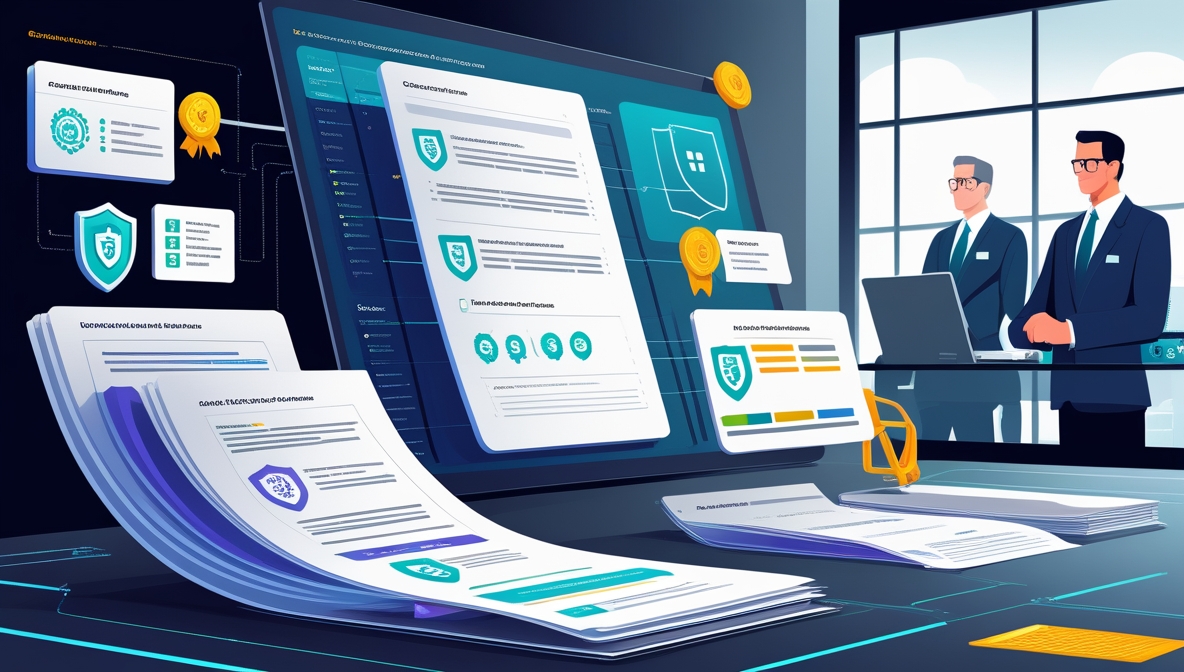A Real-World IT Governance and Cybersecurity Example You Can Learn From
This is a complete, institutional-scale example of how one large public organization designed and documented its entire IT governance and cybersecurity framework. It includes policies, templates, defined roles, risk processes, procurement rules, and more, showing what mature, operationalized IT governance looks like in practice. Unlike abstract frameworks, this example is grounded in real decisions, real constraints, and real implementation. It’s a working model you can analyze, benchmark against, and adapt to accelerate your strategy.
What’s Inside This IT Governance and Cybersecurity Example?
This resource contains a full-spectrum example of IT governance and cybersecurity documentation—spanning strategy, operations, compliance, and risk. It’s not a summary or a framework outline—it’s the real thing, offering structure, language, and artifacts that you can study and selectively apply.
- Governance Models: Organizational roles, decision matrices, and shared governance structures.
- Cybersecurity Program Design: Frameworks for risk management, incident response, endpoint protection, and awareness training.
- IT Policy Language: Examples of operational policies (e.g., access control, logging, password management, mobile device use).
- Project Management Templates: Scope documents, risk registers, change request procedures, and issue tracking formats.
- Procurement and Financial Controls: Approval tiers, delegated authority thresholds, and vendor oversight structures.
- Data Privacy Standards: Web privacy statements, data classification guidance, and control frameworks.
- Facilities and Operational Oversight: Physical security, business continuity, and disaster recovery protocols.
- Appendices and Glossaries: Definitions, acronyms, and references that clarify structure and intent.
What Can You Learn from This Example?
This example goes beyond frameworks to show how an actual institution put IT governance and cybersecurity into structured, day-to-day practice. It helps you see not only what mature policy looks like, but how it connects to strategy, operations, and results. Whether you’re starting from scratch or refining what you have, this is a detailed reference you can learn from immediately.
- Governance Structure: How to define roles, responsibilities, and decision-making authority across IT leadership and stakeholders.
- Strategic Alignment: Ways to integrate IT planning with institutional strategy using structured processes.
- Cybersecurity Operations: How to organize cybersecurity programs, including risk management, incident response, and endpoint security.
- Policy Frameworks: How to document and communicate IT policies that support compliance and accountability.
- Project Management: Real examples of project scope, risk, and change management templates you can adapt.
- Procurement Oversight: How to manage IT purchasing approvals, thresholds, and exceptions with clarity and control.
- Process Maturity: What continuous improvement and benchmarking look like in a real operational environment.
Why Should You Trust This Example of IT Governance and Cybersecurity?
This example comes from a large, complex organization operating under strict regulatory, cybersecurity, and compliance requirements. It reflects years of iteration, internal audits, and cross-functional coordination—producing a governance and cybersecurity model that is not only comprehensive, but battle-tested in the real world.
- Institution-Scale Implementation: Developed and used by a full public-sector enterprise with multi-agency coordination.
- Regulatory Rigor: Designed to meet federal, state, and board-level policy mandates—translating legal requirements into operational controls.
- Reviewed and Maintained: Routinely updated to reflect evolving standards, best practices, and lessons from audits and incidents.
- Cross-Functional Design: Aligns IT, legal, finance, risk, and operations—offering a holistic perspective that goes beyond IT silos.
- Proven Structure: Shows what “good” looks like when IT governance and cybersecurity are institutional priorities—not afterthoughts.
- Not Theory—Execution: Every section reflects actual use, with templates, procedures, and decision paths grounded in daily practice.
Why Does This IT Governance and Cybersecurity Example Matter?
Strong IT governance and cybersecurity aren’t optional—they’re the foundation for trust, performance, and resilience in any modern organization. Yet many CIOs struggle to move from abstract frameworks to practical implementation. This example bridges that gap by showing how one institution made governance real, operational, and effective. It gives you a working model to learn from, adapt, and use to accelerate your own progress.
- Closes the Strategy-to-Execution Gap: Turns high-level goals into real processes, roles, and deliverables.
- Reduces Reinvention: Save time by building on a working model instead of starting from scratch.
- Supports Risk and Compliance Efforts: Helps demonstrate due diligence and structured oversight in audits and assessments.
- Aligns IT with the Business: Shows how to prioritize, plan, and govern in lockstep with organizational goals.
- Drives Accountability: Clarifies ownership, expectations, and responsibilities across teams.
- Models Maturity: Useful for benchmarking your governance or cybersecurity program against a real, functioning structure.
What Makes It Different?
Unlike generic frameworks or theoretical whitepapers, this is a fully operationalized example from a real institution. It doesn't just describe what good governance looks like—it shows you how it's done. With full policy language, decision models, and working templates, it's the kind of resource CIOs rarely get access to—and exactly what you need when you're trying to move from ideas to action.
- Real, Not Hypothetical: Based on actual implementation—not just a recommended model or aspirational vision.
- Comprehensive and Detailed: Covers everything from IT governance and risk to procurement, operations, and cybersecurity.
- Ready-to-Use Templates: Includes sample scopes, change plans, risk registers, and more—useful out of the box.
- Policy in Practice: Shows how regulatory, strategic, and operational needs are reconciled in one cohesive structure.
- Institution-Scale Design: Built for complexity, but adaptable to small and mid-sized IT environments.
- Field-Tested: Developed in a public-sector setting with high accountability and compliance expectations.
Who Is This IT Governance and Cybersecurity Example For?
This example is built for IT leaders who want more than theory. If you're responsible for aligning IT with strategy, managing risk, ensuring compliance, or delivering consistent IT performance—you'll find this resource both relevant and actionable. It’s especially valuable if you're building or refining IT governance or cybersecurity programs in regulated, complex, or public-sector environments.
- CIOs and CTOs: Looking to formalize governance, improve accountability, and align IT with institutional goals.
- CISOs and Risk Leaders: Needing policy-backed structures for cybersecurity, data protection, and incident response.
- IT Directors and Enterprise Architects: Seeking examples to support IT planning, systems ownership, and service management.
- Public Sector and Higher Ed Leaders: Managing large IT environments under strict regulatory requirements.
- Consultants and Advisors: Providing clients with benchmarks or sample deliverables for IT governance maturity.
- Program Managers and PMOs: Wanting templates and examples to operationalize IT project governance and controls.
How to Use This Real-World Example of IT Governance and Cybersecurity
This example isn’t a one-size-fits-all solution—it’s a blueprint you can adapt to your unique environment. Use it as a reference to guide your policy development, decision frameworks, and governance structures. It’s especially powerful when paired with your own context, priorities, and organizational maturity.
- Benchmark Your Program: Compare your current governance and cybersecurity practices against a mature, real-world model.
- Adapt the Templates: Use sample scopes, risk registers, and policy outlines to build your own deliverables faster.
- Structure Decision Rights: See how roles and responsibilities are defined—and apply those lessons to your org chart.
- Design Policies with Purpose: Use the policy examples to inform how you write, approve, and maintain IT policies.
- Model Governance Workflows: Understand how approvals, exceptions, and reviews are handled and adapt them to your environment.
- Train Your Team: Share excerpts or frameworks with staff to illustrate what mature IT operations look like.
- Support Change or Compliance Initiatives: Use it as a foundation when responding to audits, implementing controls, or restructuring governance.
What It Helps You Deliver
This example empowers you to move from abstract frameworks and scattered efforts to concrete, accountable, and aligned IT outcomes. Whether you're drafting policies, structuring roles, or preparing for audits, this resource accelerates your ability to deliver high-quality governance outputs with confidence and clarity.
- Clear Governance Documentation: Role definitions, decision rights, and oversight structures tailored to your organization.
- Strategic IT Alignment: A governance approach that connects IT planning to enterprise priorities and value.
- Robust Cybersecurity Policies: Fully formed, adaptable policies covering identity, access, risk, and incident management.
- Project and Portfolio Controls: Templates and processes to manage IT initiatives with traceability and accountability.
- Procurement Integrity: Approval paths and controls that reduce risk and improve transparency in IT spend.
- Audit-Ready Processes: Documented practices that demonstrate compliance with regulatory and internal standards.
- Team and Stakeholder Clarity: Artifacts that support onboarding, communication, and shared understanding across IT and business units.
What You Can Do With It
This example gives you a concrete foundation to build from—so you’re not starting with a blank page or vague ideas. It helps you move faster, think more clearly, and make stronger decisions. You can adapt what’s relevant, skip what’s not, and use it to guide meaningful change in your IT governance and cybersecurity programs.
- Jumpstart Policy Development: Use real-world examples to draft or refine your own IT and security policies.
- Design or Refine Your Governance Model: Structure decision-making roles, escalation paths, and strategic alignment processes.
- Train or Align Your Team: Use it as a visual aid or reference point to get everyone on the same page.
- Prepare for Audits or Assessments: Show maturity and structure with documented practices and compliance-ready formats.
- Modernize Risk and Security Programs: Build a clear, practical foundation for incident response, risk classification, and endpoint controls.
- Justify Governance Investment: Use the example to make a case for resources, oversight, or process improvement.
- Benchmark Your Organization: Compare your current governance maturity against a proven, institutional-scale model.
Take the Next Step
If you're ready to bring structure, clarity, and credibility to your IT governance and cybersecurity programs, this example is your starting point. Don’t waste time reinventing what already works—see how one institution made it real, and use that insight to move your own efforts forward.
- Download the example now to study a complete, field-tested IT governance framework.
- Adapt proven templates and structures to your own context with confidence.
- Accelerate your strategy, compliance, and execution—backed by a real-world reference.
Get the Comprehensive IT Governance and Cybersecurity Example and put structured, practical IT governance within reach. MUST Read!

